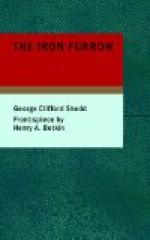From daybreak until about eight o’clock in the morning the engineer and his assistant worked on the canal line. Bryant had run a fictitious survey along the mountain side, staking it out conspicuously for any one to see, to the first of the fenced claims of the Mexican homesteaders, where it ended as if blocked; but his real line on the mesa remained unstaked.
To the low ridge, or spur of ground, projecting from the mountain’s base at a point half a mile south of his right of way through the fields, where the canal began its sweep out upon the plain, he gave considerable time. The fall of this at first was sharp, and concrete drops would have to be constructed at intervals for a distance of a mile or so in order to lower the water. When this section was left behind, he advanced rapidly along the line, for the surface of the gentle crescent swell was smooth, its grade fairly regular, and its contour fixed by nature. Essential points he marked by stones, with merely their surfaces exposed, so that if noticed they would be considered scattered pieces of rock from the hills. At the proper time they would constitute guides for later staking.
Evenings Bryant spent in developing his notes and in making tracings of the canal sections covered. During the day hours, when he knew watchful eyes were on him, he made a topographical survey of his ranch; work that he could carry on openly. The five thousand acres comprising the tract had a general direction of east and west, being about four miles long and two miles wide, which for the most part lay equally on each side of Perro Creek. By using the water of this stream during the flood season, a period of some weeks in spring and early summer, Bryant would be able very considerably to augment the supply from the Pinas. It was necessary to join the two sources in a unified system of laterals that would efficiently serve the tract; and therefore the whole enterprise required study, innumerable measurements, calculations of dirt moving, of water distribution, of dam, weir, and gate construction, of soil analysis—a cooerdination of the thousand and one matters concerned in an irrigation project that are preliminary to breaking ground. So early and late he toiled, and with him Dave Morris.
The boy indeed did enough for a man. And Bryant would sometimes arise from his drawing board where he worked after supper until midnight, to go and affectionately gaze at Dave sleeping the sleep of exhaustion.
One afternoon, when the pair were at work near the southern boundary of the ranch, Ruth Gardner came through the sagebrush to the spot, a mile from Sarita Creek.
“I could see you, just black specks, from our cabins; and since you don’t visit us, I made up my mind to visit you,” she announced. “I’ve noticed you down here for two days past. Days and days have gone by without you coming to pay another call.”
“Well, we’ve been sticking pretty steadily at our job,” Bryant replied. “Won’t you use this bag of stakes for a seat? It will keep you off the ground.”




